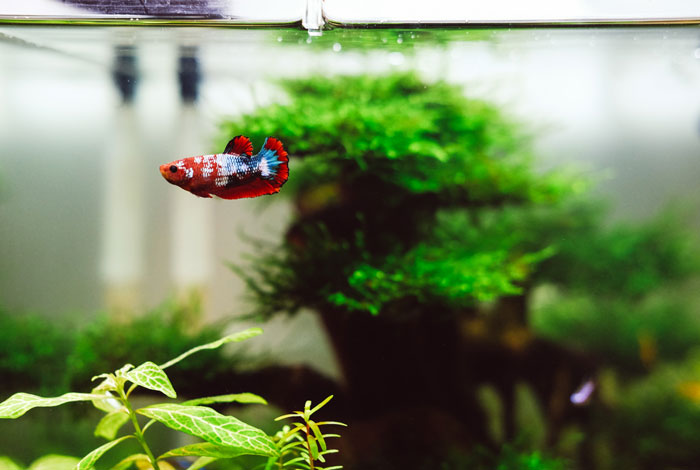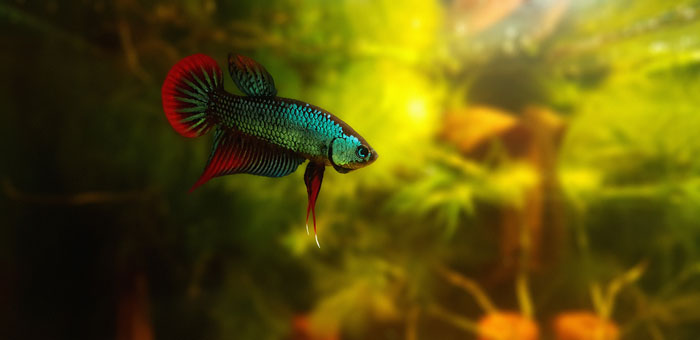Betta fish (Betta splendens) are among the most popular and beautiful pet fish to have ever swum in the aquariums of the world. However, finding your betta fish tank mates may be a bigger problem than you may originally have thought!
The reputation that the betta fish carries precedes it to even people who are not involved in the fishkeeping world. Originally known as the Siamese fighting fish, these fish were bred for their aggressive traits and were sadly pitted against one another in deadly gambling matches.
After more than ten centuries of selective breeding, modern betta fish are highly territorial, which makes getting a tank mate a tough choice!
In this blog article, we’ll go over some of the best betta fish tank mates you can get! There are lots of options, read on to learn more!

What You Will Need
In a previous article of ours called Complete Betta Fish Care Guide, not only can you learn a ton about betta fish, but we talked about how you will need a minimum of a 1-gallon tank in order to make your single betta fish comfortable.
However, if you plan on increasing the number of fish you have in a single tank, you will need to increase the size of your tank. The general rule of thumb is that every inch of fish that you have requires at least 1-gallon of water. More is better.
If you are limited on space, you can get around this rule by improving your water filtration system and increasing the frequency of water changes.
If you plan to add small crustaceans or mollusks, like a cherry shrimp or Malaysian trumpet snail, you’ll want to start with at least a 5-gallon tank and move up from there when you start introducing more fish.
During the first 72 hours of introducing a second fish, it’s also highly recommended to have a second tank ready in case one of the fish needs to be removed due to acts of aggression towards each other.
It should also be noted that male beta fish typically do not get along with other males, and males may also not get along with females either. However, if the tank is large enough, female betta fish have a higher chance of successfully cohabitating with other female betta fish.
One thing you can do when you do to reduce the chance of aggression when adding additional fish is by adding plants. Studies show that by increasing the habitat’s complexity, you’ll reduce the chance that your betta fish will show aggression to their new tank mates.
Read More: The Hidden Benefits of Almond Leaves
Introducing Your Betta Fish To Your Pre-Existing Fish Aquarium
If you have already been fishkeeping for a while now, but you want to introduce a betta fish to the community tank, there are a couple of precautions that you should take in order to make the transition as smooth as possible.
- Quarantine your betta in a separate tank for 4-6 weeks before beginning the acclimation process.
- Check to make sure that the environmental conditions of your pre-existing aquarium are adequate for your betta.
- Be careful if you have fish that have bright colors or large, flowing tails. These are triggers for betta fish and they may think that the other fish is another betta and will attack it.
- Make sure the tank is large enough.
- Adding the bettas at a young age will help socialize them and increase the chance that they will grow up to become less aggressive.
- Don’t combine your betta with fish that are notorious for fin nippers.
- Don’t combine with fish that will inhabit the upper portion of your tank, which is where your betta will spend most of its time.
If possible, it’s usually best to introduce your new betta to a community tank than introduce a fish to the betta’s tank as the other fish will already have an established hierarchy and territory.

Worst Betta Fish Tank Mates
If you want your betta fish to live a long and happy life, you’ll want to avoid getting predatory fish. All other fish that have territorial and aggressive tendencies should be avoided as well.
Fish that are also slow, brightly colored, and have large fins are also considered at risk from betta fish.
Common fish and aquatic animals to avoid are:
- Angelfish
- Tiger barbs
- Cichlids
- Goldfish
- Gouramis
- Red tail sharks
- Fancy guppies
- Puffers
- Most reptiles & amphibians
- Moray eels
- And of course, other betta fish
If you have no other choice than to have two male betta fish and are restricted with space, our Betta Box might be a perfect choice for you.
Top Betta Fish Tank Mates
As previously mentioned, not all fish can live with betta fish, especially if you want your fish to happily coexist with one another.
These aquatic animals are the perfect betta fish tank mates that you can find.
Snails
Snails are a great starter tank mate for your betta fish. They make great companions as their hard shells will protect them from curious betta fish. Snails also will clean the fish tank of algae and leftover fish food, making your job easier!
Shrimp
Particular species of shrimp, like ghost or glass shrimp, make excellent betta fish companions. They will stick to the bottom of your tank and don’t require much room. They’re also low cost and will also help you keep your tank clean!
African Dwarf Frogs
African dwarf frogs make great betta fish tank mates as they are a peaceful species. Make sure that you have a way for the frogs to get to the surface as they will require a landing to breathe upon. They’re easy to take care of and make a great addition to aquariums.
Red Roof Floaters
Red roof floaters are great tank mates for your betta fish. They are vegetation with green tops and a red, root-like structure on their underside. They float to the surface and are great for betta fish to swim through, hide in, and play in!
Corydoras Catfish
These bottom-dwelling fish are a good option for betta fish tank mates as they are non-aggressive and will live at the bottom of your tank. The best part is that they are very easy to care for. Be careful when selecting a corydoras though, as there are 160 different types of corys, and getting the wrong one could be disastrous. Panda corydoras catfish will make a great addition to smaller fish tanks.
Neon and Ember Tetras
While these fish are often colorful, if you get five or more of them at once, they will shoal, or group together, and their group will ward off territorial betta fish. These are an easy choice for those looking to get a second (and sixth!) fish while also trying to keep your betta fish happy.
Harlequin Rasboras
Harlequin fish are also shoaling fish and prefer to live in groups of five or six. They grow to be about 1.5 inches in length and live for an average of five years. They’re quite a peaceful species and will get along with your betta quite nicely.
Guppies
Guppies are a peaceful species of fish and are perfect betta fish tank mates. If you go this route, it’s important that you get feeder guppies as opposed to a long-finned variety such as the fancy guppy. Just make sure that you have a single-gender at one time unless you want a whole school of guppies living in your fish tank!
Clown Pleco
These will often need a much larger tank to live in, but they are an excellent betta fish tank mates. They are non-aggressive bottom feeders that have thick skin to repel any curious betta fish. Just make sure to purchase a clown pleco if your tank is on the smaller side, as clown plecos grow to a max of five inches. Get the wrong one, and you have a 1-2 meter problem on your hands! It should also be mentioned to avoid getting a gold nugget pleco as they are very colorful and could trigger your betta fish.
Kuhli Loaches
If your aquarium has sand, then loaches might be right for you! These bottom-dwelling fish like to bury themselves in aquarium substrate. They’re rather shy too, so they won’t be coming to the surface anytime soon, making them a great tank mate for your betta fish!
Betta Fish Sorority
Bettas are aggressive and territorial, especially when paired with another betta fish, hence the name Siamese fighting fish. There is one exception though.
You are able to have 4-5 female betta fish in a single tank. This is called a betta sorority. After an initial pecking order has been established, they will coexist with each other peacefully.
If you want to go down this route, you should keep the following things in mind:
- Get a tank that is 10+ gallons large. The more room they have available, the less likely that they will be aggressive. Also, get a longer tank rather than a taller one as bettas like to swim at the top.
- Make sure to provide plenty of vegetation for your betta fish. The more hiding places that your fish can shelter themselves, the better.
- In addition to vegetation, you’ll need to purchase some gravel, rocks, driftwood, plastic shelters, and other materials to give your bettas a place to rest.
- Reduce the stress on your fish by providing a tank that is 78°F/26°C, which is the Betta’s ideal temperature.
- The high amount of vegetation will help with the filtration process, but make sure to get a mechanical filtration system as well.
Even if you create the best environment for your betta fish, the sorority still might not work out. Keep an eye on any excessively aggressive fish. You may need to separate problem fish and put them in a different tank.

Final Thoughts On Top Betta Fish Tank Mates
Getting a tank mate for your betta fish can take a lot of time and research, but when done correctly, fishkeepers often find that the hard work leads to a rewarding result. Not only will your betta fish and their tank mates have a happy and healthy home, but you will have a beautiful aquarium that others will most certainly admire.
If you’re interested in learning more, feel free to check out the rest of our blog articles and while you’re at it, don’t forget to search through our great selection of aquariums on our website. Thanks for reading!
